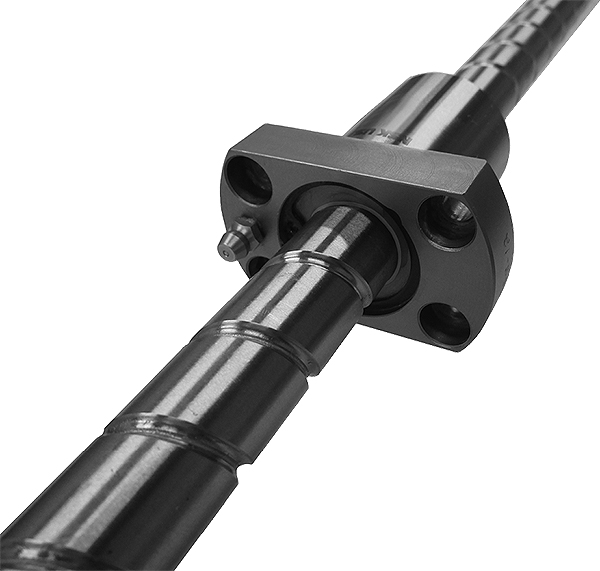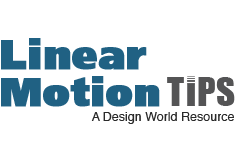by John Feitl, Senior Application Engineer and Larie Butler, Marketing Communications Specialist, NSK Americas
Ball screws have an efficiency that makes them suitable for use in actuators that drive industrial and automotive applications, including robotics, machine tool axes, and semiconductor wafer-transport systems. Here we review the different ball screw subtypes and where each one excels.
Ball screws are rotary-to-linear devices that convert movement with little friction. They have a nut that rides on a screw spindle. Within the nut are tracks that let a set of balls engage the screw spindle and a ball-return mechanism that takes the form of a return cap or tube. All of these components are key to continuous ball screw movement.

Precision-ground ball screws, sometimes called recirculating ball-bearing screws, are particularly common in machine-tool and electronic-assembly machines where precision OEM designs excel. Within CNC machinery, ball screws work on axes for wire-cutting setups, lathes, machine centers, grinding, EDM machines, and milling and planer machines. In other industrial machinery, ball screws improve the designs of textile and printing machines, packaging setups, and injection-molding designs.

The exacting designs of electronic-manufacturing machinery (such as Cartesian-robot axes, test-and-measurement equipment, and semiconductor-transport machinery) also benefit from the precision of ball screws. Still other designs that use ball screws include aerospace and aircraft actuators, thrust axes, large precision valves, and other medical and general linear-positioning applications.
Ball screw actuators compared to other options
Ball screws result in efficiencies of 90% or better thanks to rolling contact between the nut and screw, offering consistent contact and low friction. So ball screws conserve about a third more overall torque capacity than lead screws. However, engineers often choose other types of linear-motion technology for motion designs, including pneumatics, hydraulics, rack-and-pinion sets, or linear motors. But in comparison to these linear-motion alternatives, ball screws offer distinct benefits.
Pneumatic actuators versus ball screws: Ball screws can withstand higher loads than pneumatically driven axes with greater precision. That’s because pneumatic actuators use compressed gas flow into the pressure chamber to cause piston strokes. As a result, the piston’s seals are subject to stick-slip, and its motion is subject to the imprecision of force applied through compressible fluid.
Hydraulic actuators versus ball screws: Hydraulic actuators benefit from the near-incompressible nature of hydraulic fluid, which imparts higher precision than other options. Even so, ballscrews deliver greater precision without the need for a tank, fluid, filter, piping and the maintenance required for hydraulic designs.
Rack-and-pinion sets versus ball screws: Rack-and-pinions sets come with many roller and pinion forms. They’re also one of the least expensive technologies to deliver rotary-to-linear conversion of motion for precision machine axes. What’s more, racks come in lengths and versions that combine into very long strokes. That said, rack-and-pinion sets require a gearbox and provide none of the mechanical advantages of screw-based mechanisms. Without special subcomponents, most will exhibit significant backlash. In contrast, ball screws can have zero backlash as well as higher accuracy and precision.
Linear motors versus ball screw actuators: Ball screw actuators can move heavier loads than standard linear motors of a comparable size and are generally less expensive compared to linear-motor options.
Ball screw basics
Ball screw performance is measured by accuracy grade, screw shaft diameter, lead and stroke. Accuracy grade is usually specific to a given application, ranging from C0 to C5 in ground-series ball screws. Another parameter to help identify ball screw performance is screw shaft diameter — a geometry that ultimately depends on an application’s allowable space and the application’s force requirements. Lead is the distance the nut travels linearly for a 360° rotation of the shaft. Stroke is the final parameter of measurement, and it is defined as the allowable distance traveled along the length of the screw shaft.
These four factors are calculated and measured against the designer’s application requirements, including load, speed, stroke, accuracy and performance life expectations.
For example, if an application is operating under a heavy load, the manufacturer may recommend a preload. Preload is the fitting of a ball screw’s rolling elements (balls) to create axial load. The amount type and amount of preload effects the rigidity of the ball screw and ultimately the assembly’s life.
In fact, there are several ways to preload a ball screw. P-type preloading is the most cost-effective option that uses oversized balls and a single nut to boost performance. For example, a ball screw using P-type preloads the assembly up to 3% of dynamic capacity. A P-type works well for shorter nut lengths; note that it also has lower torque characteristics than other preload options.

Ball screw applications requiring higher rigidity often benefit from a Z-type preload or D-type preload. Both of these preload types can use up to 10% of dynamic capacity. Z-type preload features a single nut design with an offset to the center lead in the ball nut. In short, Z-type uses the nut to shift the lead creating the preload between ball circuits. It is a less expensive option compared to D-type, offering excellent rigidity for medium nut lengths.

D-type preload is the most expensive choice because of its double-nut design. It uses a precision spacer to get the required preload. In this case, the manufacturer uses a key to keep the nuts together for rigidity. More circuits can be added to double-nut-and-spacer design than with the Z-type to get higher load-carrying capabilities.

Tube-type ball screw options and where they work
Once design engineers determine which ball screw preload will work best, the next step is to select the recirculation type within the ball screw nut. There are four different options from which to choose, including tube, deflector, endcap, and end deflector ball-recirculation designs.

The standard and most economically priced option is tube-type recirculation. Balls are re-circulated through a ball return tube. With this type of ball screw nut design, it’s possible to reach speeds up to 100,000 dN. Note that the dN rating is an expression of the ball screw’s maximum speed capacity — as nominal shaft diameter (in mm) multiplied by maximum speed in rpm. Tube-type recirculation is very versatile and can work on many diameter and lead combinations.

Deflector-type nuts in ball screws and where they excel
Deflector-type ball screw nuts use a horseshoe-shaped tube to bridge adjacent shaft thread grooves. This allows for a compact nut design for all ball screw subtypes. Ball screws with this a deflector-type nut design can help applications reach speeds of up to 150,000 dN, though aren’t available for high lead requirements.

Ball screws with End-cap type nuts and how they work
For large leads, the End-cap type of nut is recommended. In this nut design, end caps are installed at both ends of the ball nut. Balls are then picked up and re-circulated through a hole in the ball nut. This ball screw nut design allows of up speeds to 100,000 dN, but it is the most expensive option due to having two shaft thread starts and two circuits in the ball nut. Therefore, End-cap type recirculation is best for large lead ball screws in applications needing high linear speeds.


An explanation of End-Deflector ball screws
To achieve the industry’s highest speed, quietest sound and most compact design, the End-Deflector type recirculation is the choice. This recirculation method reaches speeds of up to 180,000 dN and in some cases are six decibels quieter than other recirculation methods. The nut shape and size are 30% smaller compared to Tube type recirculation. To get all of these benefits, balls are picked up in the tangential direction at the end of the ball nut and re-circulated by a hole inside ball nut. This allows for smooth transition of a ball bearings preloaded condition to its recirculation portion of the circuit.
Ball screw selection and storage
Once design engineers determine that a ball screw is the suitable linear-motion technology for a given application, they should contact the ball screw manufacturer’s engineering department. This team will review application factors to ensure the ball screw design selected exceeds performance, accuracy and life expectations (while adhering to quality standards).
Tip: When an engineer selects a ball screw, there is consideration for all the requirements of the application, including speed, environment, and life. Some suppliers manufacture both standard and custom ball screws to meet general and specific requirements and parameters.
Before installation, store ball screws in their original package (on a flat surface) and in a clean environment to prevent potential entry of contaminants. Ball screws should come installed with lubricant, but confirm they are properly lubricated before use. Insufficient lubrication can lead to premature failure. Don’t apply any other lubrication then what was originally applied to the ball screw. The mixing of different greases is not recommended. If there is contamination or dirt, wipe the surface down with clean white kerosene and immediately reapply the same grease type.
Warning: During use, avoid overrunning the ball nut, as this can damage recirculation components. Remember that the maximum operating temperature for typical ball screws is 80° C. Consult the manufacturer if an environment will be subject to hotter temperatures or necessitate special lubrication. In addition to these suggestions, check grease every two to three months of operation and replenish as needed. One final tip: Never attempt to disassemble a ball screw. If needed, send it to the manufacturer for repair or reassembly.
NSK Americas
www.nskamericas.com


That’s good to know that ball screws are good for EDM machining. I feel like that could help you make sure that you are doing it as precisely as possible. I’ll have to look into some of those if I decide to get into EDM machining.